I have found what I think is a Lobster nymph, now I need to define what kind of lobster it is, because researching I have come across a couple of these but of different species, this looks like the Egyptian locust - Anacridium aegyptium, and also the desert locust - Schistocerca gregaria, although also the locust llanera - Rhammatocerus schistocercoides, in their solitary nymph stages they look a lot like this little friend that has been eating the leaves of my lemon balm plant.
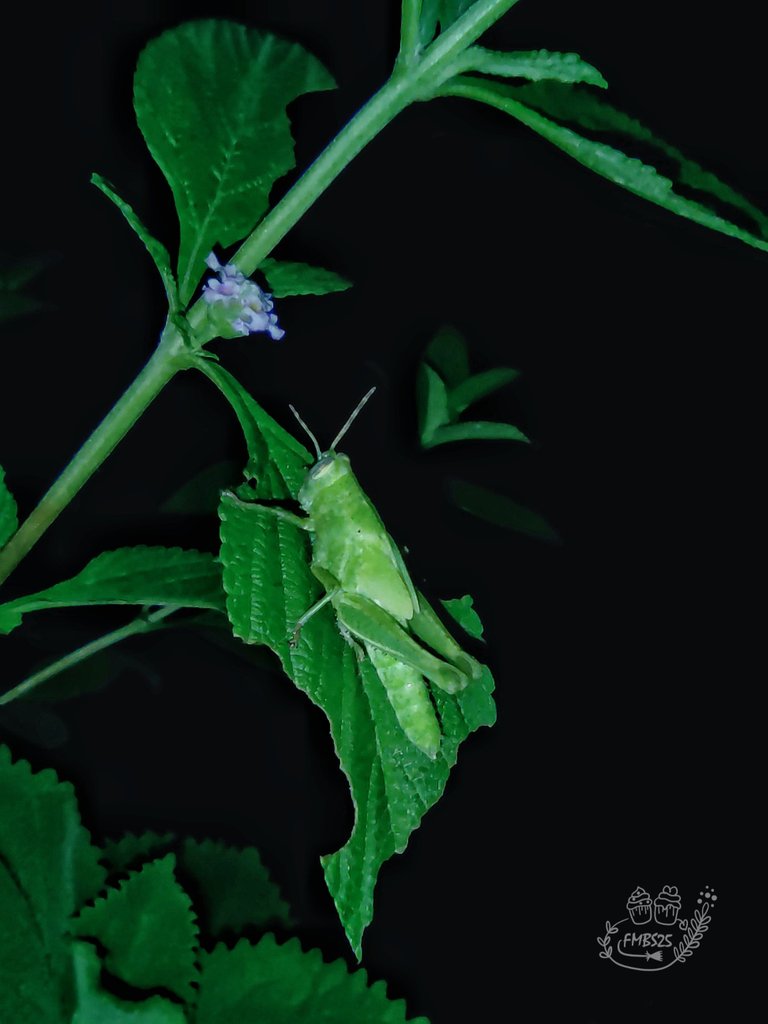
What gives me some peace of mind is that this nymph was alone around the garden, so I say it is still in the solitary phase. These three locusts that I have mentioned above, are considered pests in their gregarious nymph phase, which is when they mobilize in large swarms and are capable of wiping out entire crops. In my country Venezuela, it is common to see this type of grasshoppers or grasshoppers as they are also called, in the plains or savannas, where they have plenty of open spaces where to move and it is also common to hear their stridulation.
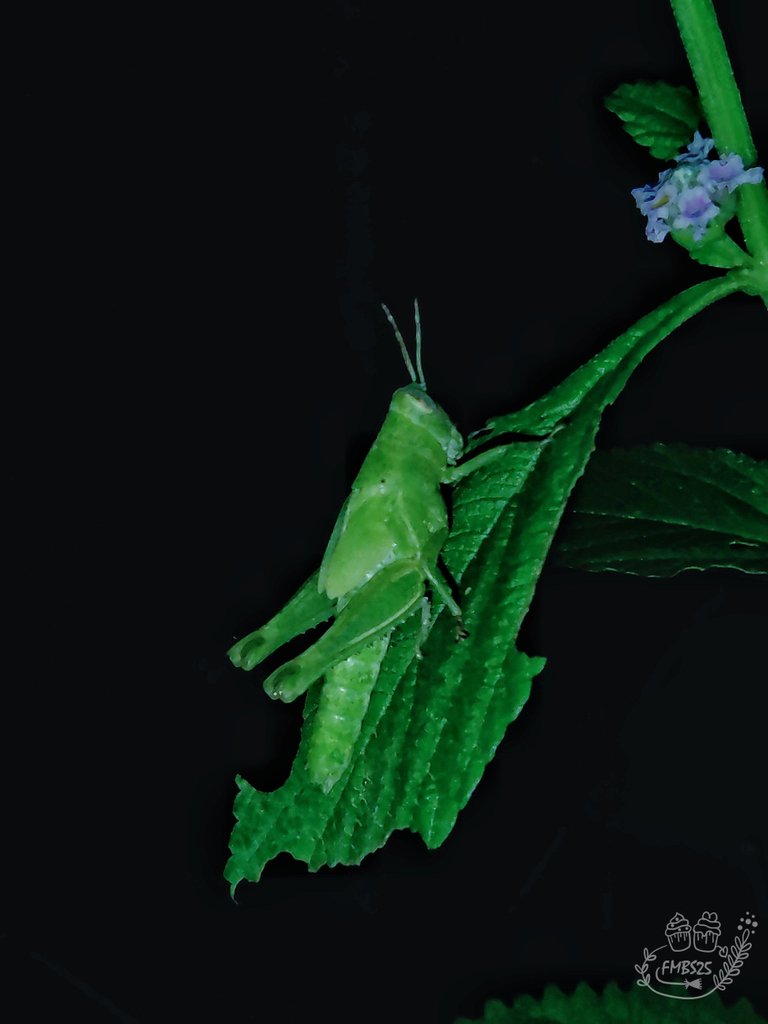
Doing further research on this little one, I am almost certain that it is not an Egyptian locust nymph, since they are not common in this part of the world, and on the contrary, the desert locust and the llanera locust, are common in Venezuela, Colombia, and Brazil, so this little one could belong to either of these two families and the only way to determine which family it belongs to, would be to wait for its mature grasshopper stage and observe its features to define its exact origin, something that I do not think will happen since these little ones rarely stay for a long time in one place.

It is said that nymphs in the solitary phase can become gregarious nymphs in a matter of hours, and change in this same time their physical appearance, from that striking green to yellow color with black spots and thus become a voracious beast that accompanied by its swarm can kill everything in its path, which is why these small insects are so feared. I just hope I don't have to witness this kind of change, and for the moment I enjoy seeing these little ones with that beautiful color.
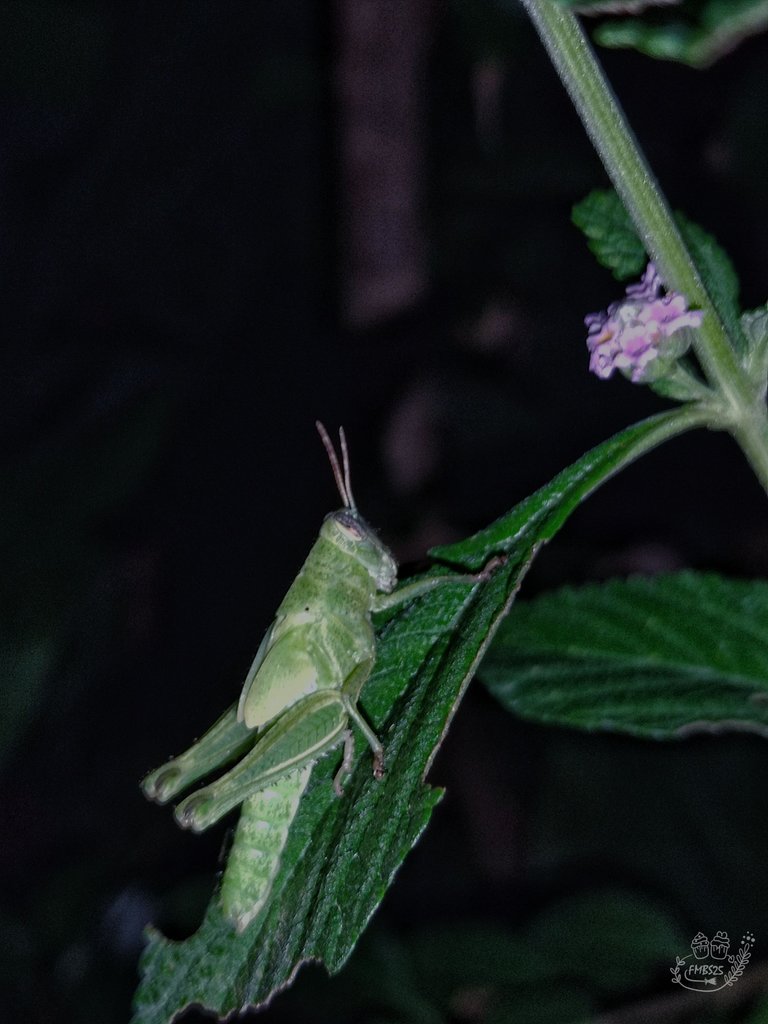
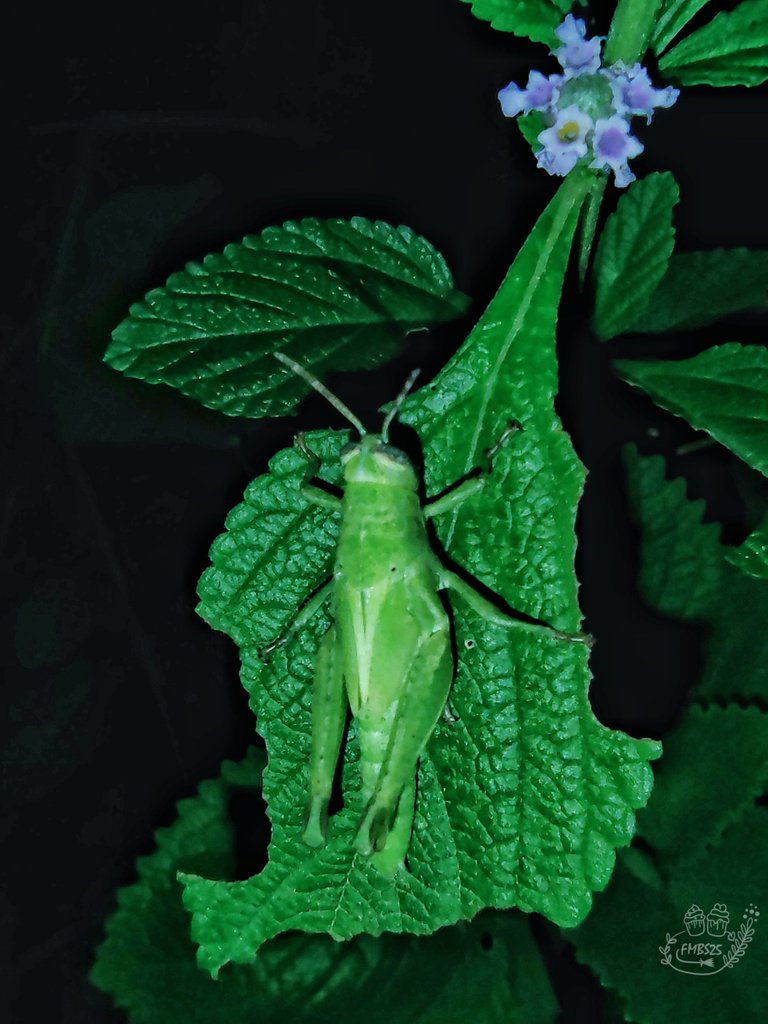
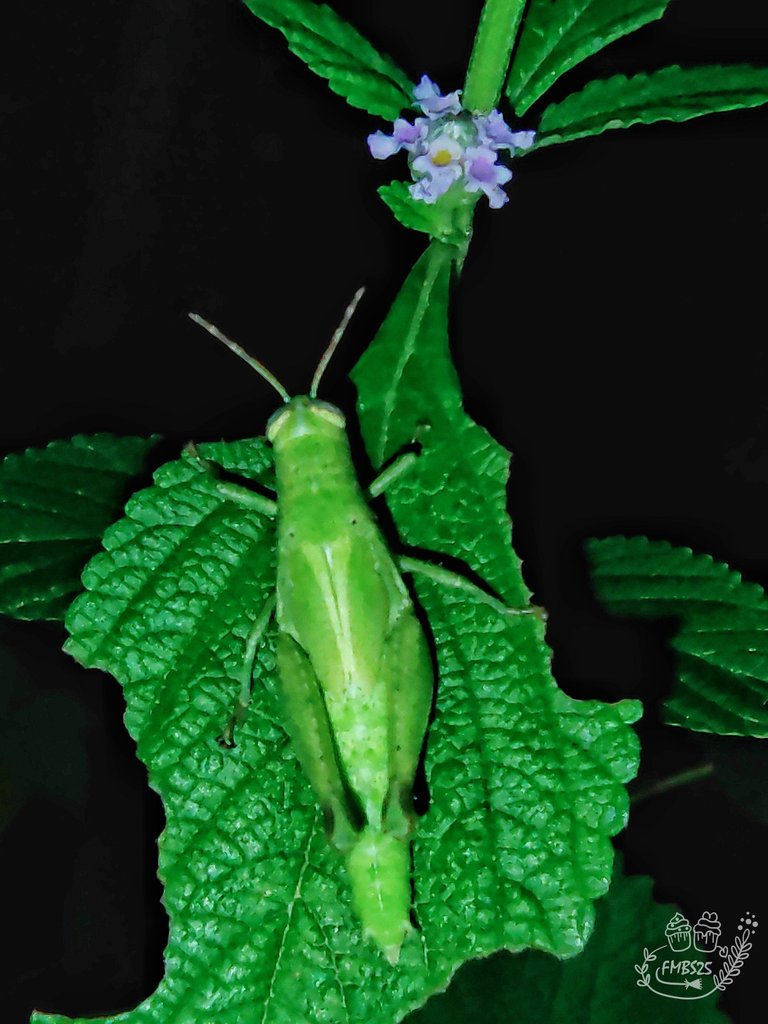


Images of my property, taken with the camera of my Xiaomi Redmi Note 9S Edited with Snapseed and PicsArt.
Thank you for taking the time to read this post, if you have any questions, criticisms, or suggestions, I would appreciate it if you would put them in the comment box, and remember, You too can make magic in the kitchen and wherever you go!


Created by @derangedvisions

What gives me some peace of mind is that this nymph was alone around the garden, so I say it is still in the solitary phase. These three locusts that I have mentioned above, are considered pests in their gregarious nymph phase, which is when they mobilize in large swarms and are capable of wiping out entire crops. In my country Venezuela, it is common to see this type of grasshoppers or grasshoppers as they are also called, in the plains or savannas, where they have plenty of open spaces where to move and it is also common to hear their stridulation.

Doing further research on this little one, I am almost certain that it is not an Egyptian locust nymph, since they are not common in this part of the world, and on the contrary, the desert locust and the llanera locust, are common in Venezuela, Colombia, and Brazil, so this little one could belong to either of these two families and the only way to determine which family it belongs to, would be to wait for its mature grasshopper stage and observe its features to define its exact origin, something that I do not think will happen since these little ones rarely stay for a long time in one place.

It is said that nymphs in the solitary phase can become gregarious nymphs in a matter of hours, and change in this same time their physical appearance, from that striking green to yellow color with black spots and thus become a voracious beast that accompanied by its swarm can kill everything in its path, which is why these small insects are so feared. I just hope I don't have to witness this kind of change, and for the moment I enjoy seeing these little ones with that beautiful color.





Thank you for taking the time to read this post, if you have any questions, criticisms, or suggestions, I would appreciate it if you would put them in the comment box, and remember, You too can make magic in the kitchen and wherever you go!

[ES]

Me he encontrado con lo que me parece es una ninfa de Langosta, ahora me falta definir qué tipo de langosta es, pues investigando me he topado con un par de estas pero de diferentes especies, esta se parece a la langosta egipcia - Anacridium aegyptium, y también la langosta del desierto - Schistocerca gregaria, aunque también la langosta llanera - Rhammatocerus schistocercoides, en sus fases de ninfa solitaria se parecen mucho a esta pequeña amiga que se ha estado comiendo las hojas de mi planta de toronjil.

Lo que me da un poco de tranquilidad es que esta ninfa estaba sola por el jardín, por lo que digo que está aún en fase solitaria. Estas tres langostas que les he mencionado anteriormente, son consideradas plagas en su fase de ninfa gregaria, que es cuando se movilizan en grandes enjambres y son capaces de acabar con cultivos enteros. En mi país Venezuela, es común ver este tipo de saltamontes o chapulines como también son llamados, en los llanos o sabanas, donde tienen bastos espacios abiertos por donde movilizarse y es además común escuchar su estridulación.

Investigando más a fondo sobre esta pequeña, estoy casi segura de que no es una ninfa de langosta egipcia, puesto que no son comunes en esta parte del mundo, y por el contrario la langosta del desierto y la langosta llanera, son comunes en Venezuela, Colombia y Brasil, así que esta pequeña puede pertenecer a cualquiera de estas dos familias, y la única manera de determinar a qué familia pertenece, seria esperar a su etapa madura de saltamontes y observar sus rasgos para definir su origen exacto, algo que no creo que suceda, pues estos pequeños rara vez se mantienen por mucho tiempo en un mismo sitio.

Se dice que las ninfas en fase solitaria pueden convertirse en ninfas gregarias en cuestión de horas, y cambiar en este mismo tiempo su apariencia física, de ese verde llamativo a un color amarillo con pintas negras y convertirse de esa manera en una voraz bestia que acompañada de su enjambre puede acabar con todo a su paso, motivo por el cual, estos pequeños insectos son tan temidos. Yo solo espero no tener que presenciar este tipo de cambios, y por el momento disfruto de ver estos pequeños con ese hermoso color.





Imágenes de mi propiedad, tomadas con la cámara de mi Xiaomi Redmi Note 9S Editadas con Snapseed y PicsArt.
Gracias por tomarse el tiempo de leer esta publicación, si tiene alguna pregunta, crítica o sugerencia, la agradecería que la pusiera en la caja de comentarios, y recuerda, ¡Tú también puedes hacer magia en la cocina ya dondequiera que vayas!


Created by @robinsonlgil




Come and support @Cervantes as Witness in https://peakd.com/me/witnesses



Lo que me da un poco de tranquilidad es que esta ninfa estaba sola por el jardín, por lo que digo que está aún en fase solitaria. Estas tres langostas que les he mencionado anteriormente, son consideradas plagas en su fase de ninfa gregaria, que es cuando se movilizan en grandes enjambres y son capaces de acabar con cultivos enteros. En mi país Venezuela, es común ver este tipo de saltamontes o chapulines como también son llamados, en los llanos o sabanas, donde tienen bastos espacios abiertos por donde movilizarse y es además común escuchar su estridulación.

Investigando más a fondo sobre esta pequeña, estoy casi segura de que no es una ninfa de langosta egipcia, puesto que no son comunes en esta parte del mundo, y por el contrario la langosta del desierto y la langosta llanera, son comunes en Venezuela, Colombia y Brasil, así que esta pequeña puede pertenecer a cualquiera de estas dos familias, y la única manera de determinar a qué familia pertenece, seria esperar a su etapa madura de saltamontes y observar sus rasgos para definir su origen exacto, algo que no creo que suceda, pues estos pequeños rara vez se mantienen por mucho tiempo en un mismo sitio.

Se dice que las ninfas en fase solitaria pueden convertirse en ninfas gregarias en cuestión de horas, y cambiar en este mismo tiempo su apariencia física, de ese verde llamativo a un color amarillo con pintas negras y convertirse de esa manera en una voraz bestia que acompañada de su enjambre puede acabar con todo a su paso, motivo por el cual, estos pequeños insectos son tan temidos. Yo solo espero no tener que presenciar este tipo de cambios, y por el momento disfruto de ver estos pequeños con ese hermoso color.





Gracias por tomarse el tiempo de leer esta publicación, si tiene alguna pregunta, crítica o sugerencia, la agradecería que la pusiera en la caja de comentarios, y recuerda, ¡Tú también puedes hacer magia en la cocina ya dondequiera que vayas!






 @Ecotrain Discord @Ecotrain Discord |  |
|---|---|
| https://steemitimages.com/640x0/https://ipfs.busy.org/ipfs/QmNmqVvqjT9vUukyqi1PWVvceFNA32BUqpMj1kME7PdSib @upmewhale Discord |  |



